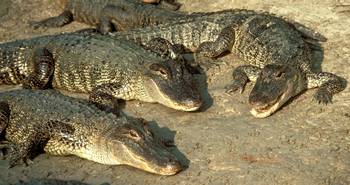- If You See an Alligator
- American Alligator Fact Sheet
 (PDF 293.1 KB)
(PDF 293.1 KB) - Alligators in Texas: Rules, Regulations and General Information
 (PDF 1.6 MB)
(PDF 1.6 MB) - Alligator Farming in Texas
 (0 B)
(0 B) - History of Alligators in Texas
- Managing Alligator Populations
- Alligators at Brazos Bend State Park
- American Alligator Research
Managing Alligator Populations

© TPWD 2003/Photo by Mario Gonzalez
In order to understand and properly manage Texas's alligator population, TPWD Wildlife Division conducts extensive studies in the state on the number, character and harvest of alligators every year. This information helps TPWD determine trends in the population, assess alligator habitat and establish wise hunting limits for the species.
TPWD Wildlife Division staff monitors the Texas alligator population via aerial nest surveys and night time "spotlight" counts. For example, in 2001, TPWD Staff conducted 24 hours of helicopter surveys in the state and documenting hundreds of alligator nests. In addition, staff conducts annual spotlight counts along 41 established lines covering 22 counties to supplement aerial survey estimates and provide population estimates in heavily vegetated areas.
Harvest recommendations for each season are determined by TPWD biologists using a 3-year average nest count, the percentage of adult alligators in a population, and a sustained yield harvest rate. Alligator season begins September 10th and ends September 30th. The number of alligators an individual landowner may harvest is based on the acreage and type of habitat owned.
Based on data acquired, TPWD allows egg collection, farming, and hunting activities for alligators by permit. Annual harvest records are kept, to document harvest size, sex, county of take and harvest date. This information is useful in finding trends in the species as well as hunter profiles. All aspects of the alligator program are carefully monitored.